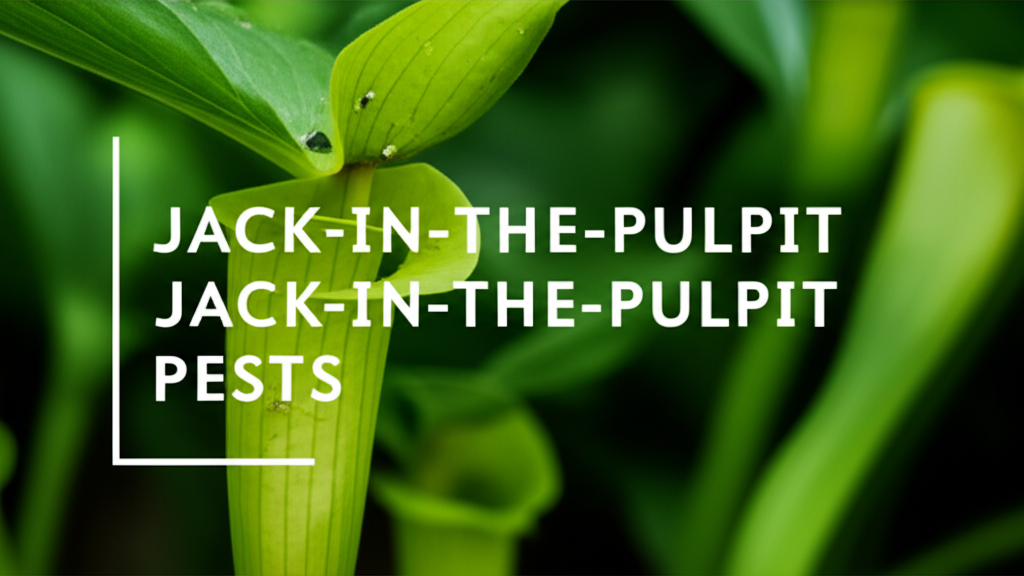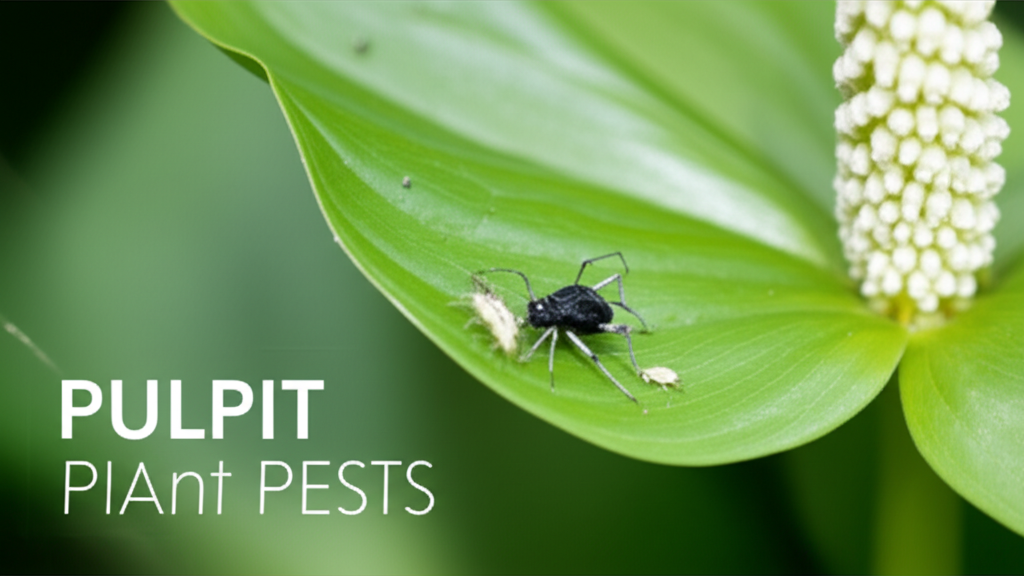Introduction to the Jack-in-the-Pulpit and Its Vulnerabilities
The Jack-in-the-Pulpit (Arisaema triphyllum) is a captivating woodland wildflower native to eastern North America. Its unique spathe, resembling a preacher in its pulpit, and its distinctive spadix, the “Jack,” make it a focal point in shady, moist woodland gardens and natural settings. This herbaceous perennial, part of the Araceae family (which also includes houseplants like Peace Lilies and Philodendrons), is prized for its distinctive form and the attractive berry clusters that develop in late summer. However, like many plants, the Jack-in-the-Pulpit is not immune to the attentions of various pests, which can detract from its aesthetic appeal and even threaten its health. Understanding these common adversaries is crucial for anyone cultivating or simply admiring this fascinating plant. This article will delve into the most frequent insect and invertebrate pests that target the Jack-in-the-Pulpit, detailing their characteristics, the damage they inflict, and effective management strategies.
Key Pests Attacking Jack-in-the-Pulpit

Several invertebrate species have a penchant for the succulent leaves, stems, and sometimes even the corms of the Jack-in-the-Pulpit. Identifying the culprit is the first step in addressing the problem effectively.
Slugs and Snails
Perhaps the most ubiquitous and frustrating pests for many woodland gardeners, slugs and snails are gastropods that thrive in the moist, shady conditions favored by the Jack-in-the-Pulpit.
- Characteristics: Slugs are shell-less mollusks, often slimy and ranging in color from gray and brown to green and black. Snails are their shelled counterparts. Both are nocturnal or active during damp, overcast weather.
- Damage: They are voracious leaf-eaters, leaving behind characteristic irregular holes and chewed margins. Their presence is often betrayed by glistening trails of mucus on leaves and soil. Severe infestations can decimate young foliage, weakening the plant and making it susceptible to other issues.
Aphids
These small, soft-bodied insects are common plant pests across a wide range of species, and the Jack-in-the-Pulpit is no exception.
- Characteristics: Aphids are typically pear-shaped, with long antennae and two prominent cornicles (tube-like structures) on their abdomen. They come in various colors, including green, black, yellow, and pink. They reproduce rapidly, often giving birth to live young.
- Damage: Aphids feed by sucking sap from new growth, including leaves, stems, and flower stalks. This feeding can cause stunted growth, distorted leaves, and yellowing. A sticky residue called honeydew is also excreted, which can attract sooty mold, a black fungus that further hinders photosynthesis.
Spider Mites
These tiny arachnids, often too small to see with the naked eye, can cause significant damage, especially during dry, hot periods.
- Characteristics: Spider mites are typically red, brown, or green and spin fine webbing on the undersides of leaves and along stems.
- Damage: They pierce plant cells and suck out the sap, leading to a stippled or bronzed appearance on the leaves. As infestations worsen, leaves can become dry, brittle, and eventually drop off. The fine webbing is a tell-tale sign.
Fungus Gnats
While the adult fungus gnat is a minor nuisance, its larvae can be problematic for plants, particularly those growing in consistently moist soil.
- Characteristics: Adult fungus gnats are small, dark, mosquito-like flies that hover around the soil surface. The larvae are tiny, translucent worms with black heads.
- Damage: The larvae feed on decaying organic matter in the soil, but if conditions are consistently wet, they can also feed on fine roots and delicate seedlings. While less common on mature Jack-in-the-Pulpit corms, persistently wet conditions can encourage larvae to damage root systems.
Cutworms
These larval stages of moths are notorious for their destructive feeding habits, particularly on young plants.
- Characteristics: Cutworms are typically dull-colored, smooth-bodied caterpillars that curl into a “C” shape when disturbed. They live in the soil and emerge at night to feed.
- Damage: They are named for their habit of “cutting off” seedlings and young plants at the soil line. They can also chew into stems and leaves. The damage often appears as plants suddenly wilting or falling over.
White Grubs (Grubs)
These are the larval stages of various beetles, including Japanese beetles and June bugs, and can cause significant damage to plant roots.
- Characteristics: Grubs are C-shaped, creamy white larvae with brown heads. They live in the soil and feed on plant roots.
- Damage: They chew on the root systems of plants, which can lead to wilting, stunted growth, yellowing leaves, and in severe cases, plant death. They are often found in lawns but can infest garden beds where Jack-in-the-Pulpit is grown.
Identifying Pest Damage on Jack-in-the-Pulpit
Recognizing the signs of pest infestation is crucial for timely intervention. Different pests leave distinct marks.
Leaf Damage Patterns
- Slugs/Snails: Irregular holes, chewed edges, and slime trails.
- Aphids: Stunted or curled new growth, yellowing leaves, sticky residue.
- Spider Mites: Fine webbing, stippled or bronzed foliage, leaf drop.
- Cutworms: Severed stems at the soil line, chewed leaf edges on young plants.
- Grubs: Wilting, yellowing leaves, and a general lack of vigor due to root damage.
Visual Inspection
Regularly inspect your Jack-in-the-Pulpit plants, paying close attention to the undersides of leaves, new growth, and the soil surface, especially during the evening or after rain.
Management Strategies for Jack-in-the-Pulpit Pests
A multi-pronged approach, often referred to as Integrated Pest Management (IPM), is the most effective way to manage pests on your Jack-in-the-Pulpit. This involves a combination of cultural, biological, and, if necessary, chemical controls.
Cultural Control Methods
These methods focus on creating an environment that is less favorable to pests.
- Soil Health and Drainage: Ensure good soil drainage to deter slugs and prevent conditions favorable for fungus gnat larvae. Healthy soil supports robust plants that are more resistant to pest damage.
- Weeding: Remove weeds that can harbor pests and compete with your plants for resources.
- Plant Spacing: Adequate spacing allows for better air circulation, which can reduce humidity and deter some pests like slugs and fungal diseases that may exacerbate pest problems.
- Sanitation: Remove plant debris in the fall to eliminate overwintering sites for some pests.
Biological Control Methods
Leveraging natural predators and beneficial organisms can significantly reduce pest populations.
- Attracting Beneficial Insects: Encourage predatory insects like ladybugs (which eat aphids) and lacewings by planting a diverse range of native plants that provide habitat and nectar sources.
- Introducing Beneficial Nematodes: For soil-dwelling pests like grubs and cutworm larvae, beneficial nematodes can be introduced to the soil to parasitize and kill them.
Mechanical and Physical Control Methods
These involve directly removing or deterring pests.
- Handpicking: For slugs, snails, and larger caterpillars like cutworms, manual removal is effective, especially when done in the early morning or evening.
- Barriers: Copper tape around pots or garden beds can deter slugs and snails. Diatomaceous earth, applied around the base of plants, can dehydrate and kill crawling insects.
- Watering Practices: Water at the base of the plant in the morning to allow foliage to dry before evening, making it less attractive to slugs and snails. Avoid overwatering, which can encourage root pests.
Chemical Control Methods (Use as a Last Resort)
When infestations are severe and other methods fail, targeted chemical treatments may be considered, always opting for the least toxic options first.
- Insecticidal Soaps and Horticultural Oils: These are effective against soft-bodied insects like aphids and spider mites. They work by suffocating the pests.
- Slug and Snail Baits: Use baits cautiously, as some can be harmful to non-target organisms. Iron phosphate-based baits are considered more environmentally friendly.
- Botanical Insecticides: Neem oil is a natural insecticide derived from the neem tree that can disrupt insect growth and feeding.
Key Facts and Comparison of Common Pests
The following table provides a quick reference to the common pests of Jack-in-the-Pulpit, their typical damage, and preferred conditions.
| Pest | Primary Damage | Visible Signs | Preferred Conditions |
|---|---|---|---|
| Slugs & Snails | Leaf consumption (irregular holes) | Chewed leaves, slime trails | Moist, shady environments, cool temperatures |
| Aphids | Sap-sucking, stunted growth | Clustered insects on new growth, sticky honeydew, distorted leaves | New, tender growth, moderate to warm temperatures |
| Spider Mites | Sap-sucking, leaf desiccation | Fine webbing, stippled/bronzed leaves | Hot, dry, dusty conditions |
| Cutworms | Stem cutting, leaf feeding | Severed seedlings at soil line, chewed leaves | Soil-dwelling, active at night |
| Grubs | Root damage | Wilting, yellowing leaves, general plant decline | Soil-dwelling, prefer moist soil |
Pros and Cons of Different Management Approaches
Each pest management strategy has its advantages and disadvantages. A balanced approach often yields the best results.
| Strategy | Pros | Cons |
|---|---|---|
| Cultural Control | Prevents infestations, improves plant health, sustainable | May not be sufficient for severe infestations, requires consistent effort |
| Biological Control | Natural, targets specific pests, minimal environmental impact | Can be slow to establish, effectiveness depends on environmental factors, some beneficials are costly |
| Mechanical/Physical Control | Immediate results, non-toxic, targeted | Labor-intensive, may not be practical for large areas or hidden pests |
| Chemical Control (least toxic first) | Fast-acting, effective for severe infestations | Can harm beneficial insects and pollinators, potential for resistance, environmental risks, requires careful application |
Prevention is Key: Building a Resilient Jack-in-the-Pulpit Ecosystem
The most effective way to manage pests on your Jack-in-the-Pulpit is through proactive prevention. This involves creating a healthy and balanced garden ecosystem.
Encouraging Natural Predators
As mentioned, attracting beneficial insects is a cornerstone of biological pest control. A diverse planting scheme that includes native wildflowers, herbs, and flowering plants will provide food and habitat for predators that naturally keep pest populations in check.
Maintaining Optimal Growing Conditions
Jack-in-the-Pulpit plants that are stressed by poor growing conditions (e.g., improper watering, insufficient light, poor soil) are more susceptible to pest attack.
- Watering: Provide consistent moisture, but avoid waterlogged soil. Water deeply and less frequently, allowing the soil to dry slightly between waterings.
- Soil: Amend the soil with organic matter to improve drainage and nutrient content.
- Light: Ensure the plant receives appropriate dappled shade.
Regular Monitoring
Consistent scouting of your plants is invaluable. Early detection of pests means you can address a problem when it is small and easier to manage, often before any significant damage occurs.
Conclusion
The Jack-in-the-Pulpit is a truly unique and rewarding plant to cultivate. While it can be targeted by several common garden pests, understanding their identity and the damage they cause is the first step towards successful management. By employing a combination of cultural, biological, and mechanical controls, and resorting to chemical interventions only when absolutely necessary and with caution, you can protect your Jack-in-the-Pulpit and ensure its healthy, vigorous growth for years to come. A thriving garden is one where nature’s balance is respected, and a little vigilance goes a long way in keeping these fascinating woodland gems pest-free.


